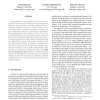Free Online Productivity Tools
i2Speak
i2Symbol
i2OCR
iTex2Img
iWeb2Print
iWeb2Shot
i2Type
iPdf2Split
iPdf2Merge
i2Bopomofo
i2Arabic
i2Style
i2Image
i2PDF
iLatex2Rtf
Sci2ools
CVPR
2007
IEEE
2007
IEEE
Semi-supervised Hierarchical Models for 3D Human Pose Reconstruction
Recent research in visual inference from monocular images has shown that discriminatively trained image-based predictors can provide fast, automatic qualitative 3D reconstructions of human body pose or scene structure in realworld environments. However, the stability of existing image representations tends to be perturbed by deformations and misalignments in the training set, which, in turn, degrade the quality of learning and generalization. In this paper we advocate the semi-supervised learning of hierarchical image descriptions in order to better tolerate variability at multiple levels of detail. We combine multilevel encodings with improved stability to geometric transformations, with metric learning and semi-supervised manifold regularization methods in order to further profile them for taskinvariance ? resistance to background clutter and within the same human pose class differences. We quantitatively analyze the effectiveness of both descriptors and learning methods and show th...
Computer Vision | CVPR 2007 | Human Body Pose | Human Pose Class | Human Pose Estimates | Semi-supervised Learning | Semi-supervised Manifold Regularization |
| Added | 12 Oct 2009 |
| Updated | 12 Oct 2009 |
| Type | Conference |
| Year | 2007 |
| Where | CVPR |
| Authors | Atul Kanaujia, Cristian Sminchisescu, Dimitris N. Metaxas |
Comments (0)

